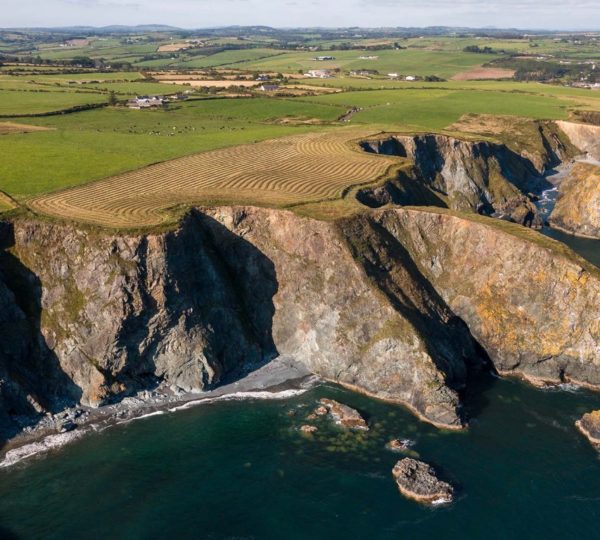Mining Heritage of the Copper Coast
Discover the Rich Mining Heritage of the Copper Coast
The cliffs west of Bunmahon were mined for lead, silver and copper in the 18th Century. However the main phase of activity was the mid 19th century when the mines east of Bunmahon were worked by the Mining Company of Ireland. Their operation fell into two phases.
The cliffs west of Bunmahon were first mined for lead, silver, and copper in the 18th century, marking the beginning of the region’s rich mining history. However, the most significant period of activity occurred in the mid-19th century when the Mining Company of Ireland took over operations east of Bunmahon. This phase unfolded in two distinct periods, transforming the landscape and economy of the area. The company’s work left a lasting legacy, with remnants of the infrastructure still visible today, serving as a testament to the industrial heritage that shaped the Copper Coast

Places of Interest
The Mining Company of Ireland was established in Dublin in 1824 and quickly took leases on mineral areas all over the country. Knockmahon proved to be the most profitable of all their operations though it took ten years of development before they began to be profitable By 1840 it was described as ‘the most important — mining district in the empire’. This proved to be the peak, however, and by the mid 1840s they were working at depths of almost a quarter of a mile and the same distance under the sea bed at increasing expense. In their search for other lodes in the neighbourhood they discovered Tankardstown just as Knockmahon was threatening to flood.
In 1850 the company began to move their entire operation east to Tankardstown, including engines and engine houses. Over the next 15 years the price of copper fluctuated and the company varied their production and sales accordingly. A peak was reached in 1865 followed by a fairly consistent decline. Hopes for an upturn in prices and a new discovery in the Bunmahon area faded through the 1870s and the last few tons were sold from Tankardstown in 1879. The engines were sold for scrap and all that remains of the mining operation that once employed 1200 people are the gaunt ruins of the engine houses on the cliffs at Tankardstown. Entire extended families moved away, mainly to America where some of them wound up working at the Copper Mountain in Butte, Montana. Most had nobody left home to write so all contact with them was lost. A few did come back to participate in an attempt revival in 1906, but that was short lived and they left again.
- Underground
A miner named Lewis had his leg broken in 3 places by a rock-fall in Autumn 1833. His fellows carried him to a hospital in Waterford in a litter on their shoulders. An unnamed miner had a lucky escape the following Spring when he slipped off the ladder, fell 84 feet and sustained only a few cuts to his head and thumb. Most unlucky was James Brien in the Summer of 1838 who having drilled a hole for blasting, performed the familiar task of tamping in the gunpowder when somehow he created a spark and the explosion drove the tamping rod right through his chest. A more usual type of accident was a rock-fall such as killed Patrick Flynn some three months later.
A nightmare accident and the solidarity of the miners in affecting a rescue in April 1840 is graphically reported by “A Correspondent” to the Waterford Mail and this was taken up by many papers in Ireland and U.K. where it was found 30 years later and reproduced again by W.J. Henwood.: “ – the imprudent removal of a prop (stull) caused many thousand tons of rubbish to fall on Michael Walsh of Bonmahon –at the 66 fathom level beneath the sea. – a strong party was instantly employed as well to extricate the body as to reopen the drift and repair the damage. After the men had worked twenty four hours, however, they were astonished to hear the voice of their lost comrade –. He told them that his knees almost touched his chin, that salt water had risen almost to his mouth and that he had eaten his last candle. –the displacement of every stone occasioned some, and often dangerous, movement in the mass; men were bold enough to worm themselves through the crevices but were unable to reach him before the lapse of the second day – at intervals he became delirious. – small quantities of food were passed to him through opening between the stones and at the end of the third day he was set free. His limbs of course were cramped from the straitened position in which he was confined, he was benumbed by long immersion and weak from fasting, but otherwise he was unhurt. A weary time passed before his recollection returned and he recovered his strength: he never resumed his place underground but he is still (1868 Henwood) employed on light jobs at the surface.” Another Correspondent to the Waterford Chronicle says that on 29th April the roof of the 72 fathom level (possibly judged from surface) collapsed; all escaped except Michael Walsh. John Petherick organised the rescue. An English miner named Perkins is mentioned as well as local man Fardy Doyle and a local priest went down to hear his confession. The risks involved are stated, the “staining and cracking of timbers” which at times “sounded like pistol shots”. Walsh had been trapped from Wednesday to Saturday and emerged “sore, but not disfigured”.
There is a brief report the following year of a miner named Kennedy falling down a shaft and being seriously injured. Two years later a labourer, Joseph Martin, “fell into one of the pumps” (not clear what that means) and badly injured was carried into the Leper Hospital, Waterford. In Nov. 1844 another rock-fall badly injured 34 year old Edward Troy from Dungarvan. They got him to the surface but he died there. Seven years passed without reported accident until March 1851 when the ground gave way at the 100 fathom level at Knockmahon beneath an unnamed miner who dropped 70 feet. Somehow he was unhurt, climbed the ladders and walked home. Four years later, two unnamed miners, testing the old mine at Temleyvrick, were drilling for a blast but knocked through to a flooded previous working. They had no hope against the surge of water and debrii. It took twenty six hours to clear the working while their wives and children keened above. Their battered bodies were finally raised returned to their widows, one left with six children, one with eight. The following year Michael Whelan was badly injured in a blast that went wrong. They also got him to the surface and home but he died two days later.
If other accidents took place in the intervening eight years they are not report. In 1864 a slab of ground gave way under miners John Murphy and Thomas Sliney. The latter, aged 32, died leaving a widow and children (noted in the Death Registers). However, the reported tragedy of a father and son named Cooney being killed in a single roof-fall did get attention.Strangely the Death Register records the accidental death of 57 year old miner John Cooney it makes no mention of his son. Interesting social detail emerges from the report on an accident two years later. James Phelan had gone to America with his family. When his wife died he returned to Bunmahon leaving his two sons working over there. James and Patrick Cunningham were operating at the 90 fathom level in Tankardstown when a large part of the roof fell reportedly blowing Patrick clear but crushing returnee James Phelan. Again the Death Register tells a different story: it was Patrick Cunningham who died with no mention of James Phelan. The accidental death of 32 year old miner William Kennedy is reported in 1871. During blasting a roof stone was dislodged which hit him. He left a widow Ann (nee Butler) and six children under 7 years old. At the inquest MCI were held not to blame.
While visiting the Copper Coast, you can see some of the witnesses of this activity at different locations:
Stage cove / Knockmahon (Bunmahon)
There you can see the remnants of the :
walls of the copper storage yard, with blocks of white quartz containing green copper;
adits (horizontal tunnels) in the cliffs, alignment giving clue to the shape of the ore vein;
shafts (vertical tunnels) on the headland, copper stains on the slipway;
facilities for shipping the ore out to Swansea, Wales; click here for a link to a video representation of the Hafod Copper Works where the ore from the Copper Coast was processed.
cobbled floor that may have formed part of the quay side;
mineral tramway route, connecting Tankardstown to the primary ore dressing floors at Bunmahon.
Tankardstown Engine Houses (1km east of Bunmahon)
Tankardstown Cornish Engine Houses are some of the main characteristic buildings linked to the copper mining industry. They were built around 1860 to pump water out of the copper mines and to wind ore up from the depths. The developments undertaken with InterReg IIIB funding related to these ruins include:
Excavation works
Excavation works were led during summer 2004 by the Department of Archeology – University College Cork, under the overall supervision of Dr. Colin Rynne.
Conservation works
Interpretative Signs
A mining trail was built on site with interpretation boards explaining the use of the different buildings (with reconstruction drawings) during the mining activity in the 19th Century and the use of copper in our everyday life.

